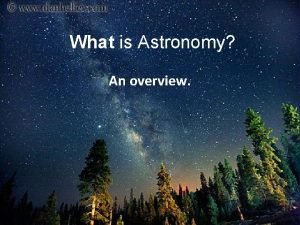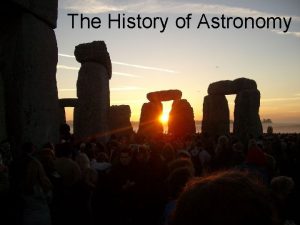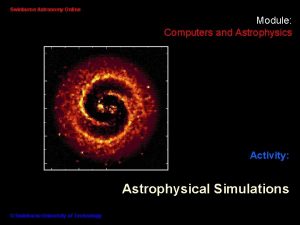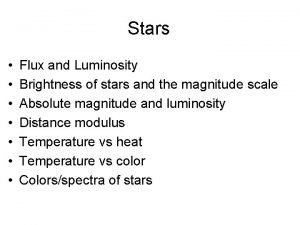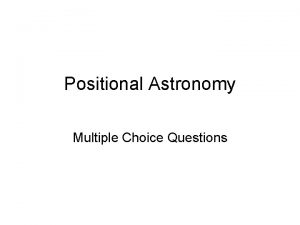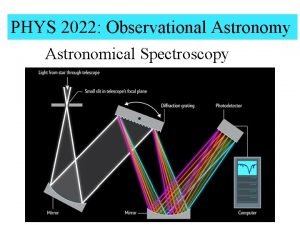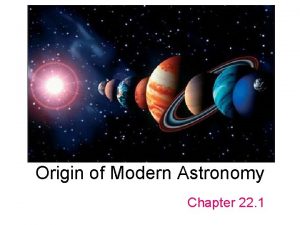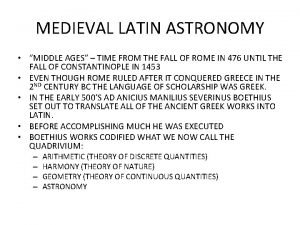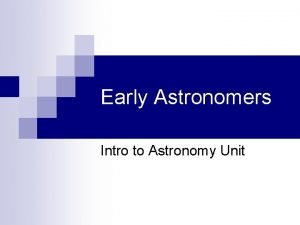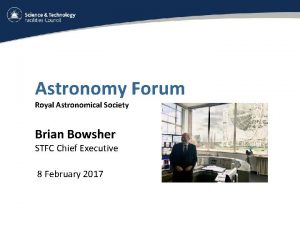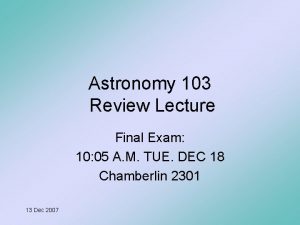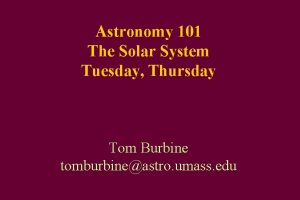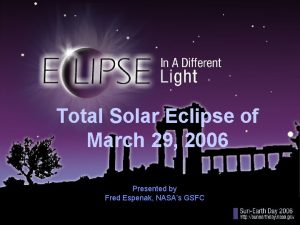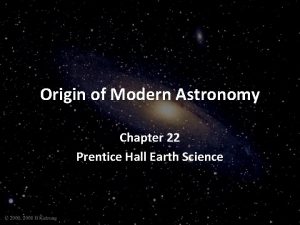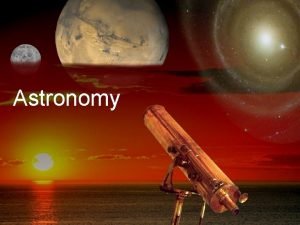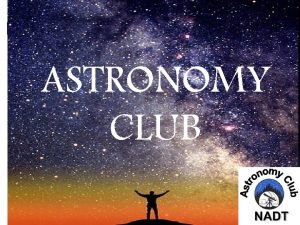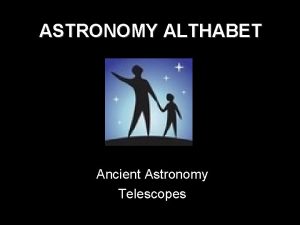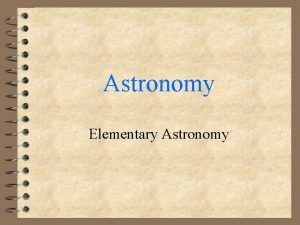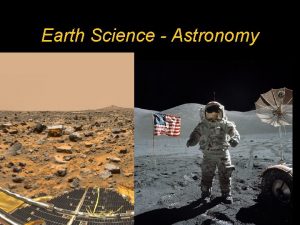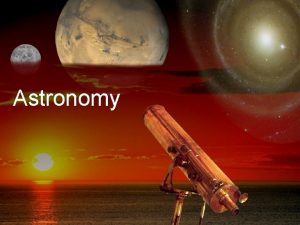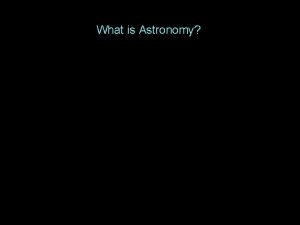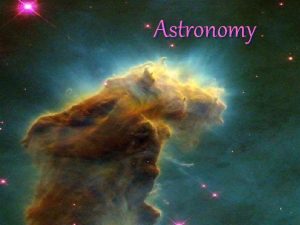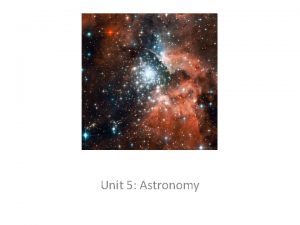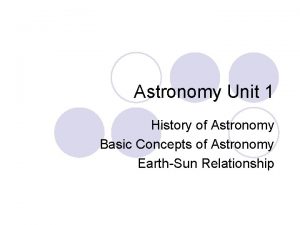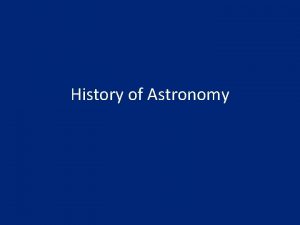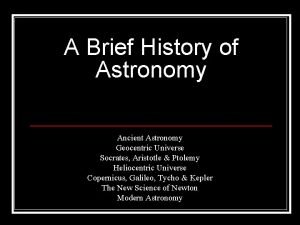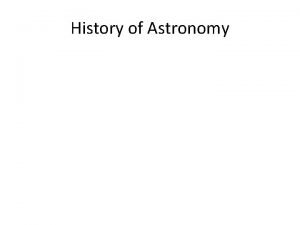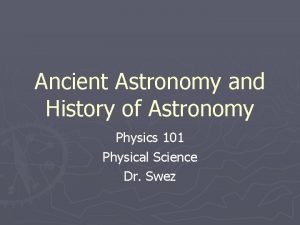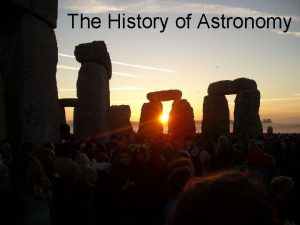History of Astronomy UNIT 1 HISTORY OF ASTRONOMY





























- Slides: 29

History of Astronomy UNIT 1 – HISTORY OF ASTRONOMY PP 2 ASTRONOMY MR. THOMPSON

REVIEW Study of the universe, which includes the planets and their satellites, comets, meteors, stars and interstellar matter and star systems. Astronomy

REVIEW The orderly arrangement of the universe. Cosmos

REVIEW The belief the positions of celestial objects (i. e stars, planets) affect the way events occur on Earth. Astrology

REVIEW The oldest field of astronomy. (Hint: Deals with precise measurements of celestial objects) Astrometry

REVIEW The study of the astronomy of ancient people. Archeoastronomy

HISTORY OF ASTRONOMY • Astronomy is the oldest discipline of science. • Developed from simple observations about the movement of the sun and moon. • Now, explores sophisticated theories about the nature of the universe.

EARLIEST CIVILIZATIONS • Nomadic cultures looked to the heavens for guidance and changes in natural cycles to survive year-to-year. • Nomads – people without fixed habitation • Later, the first farmers relied on the changes in the heavens to tell them of the coming of spring, summer, fall and winter.

FIRST TRUE EARLIEST CIVILIZATIONS The first, true earliest civilizations were: • China – along the Hwang Ho River • India – along the Indus River • Assyrian (Babylonia and Samaria) – along the Tigris and Euprates Rivers • Called Mesopotamia meaning “land between 2 rivers” • Egypt – along the Nile River

EARLIEST CIVILIZATIONS

EARLY CHINESE CIVILIZATION – ASTRONOMY • The Chinese worshipped many celestial bodies, including the Sun. • The Great Temple at Peking is oriented to point towards the rising mid-winter Sun.

EARLY CHINESE CIVILIZATION – ASTRONOMY • Chinese astronomers produced one of the 1 st accurate document, calendars, of a year having 365. 25 days. • This was determined by looking at the continual movements of the stars. • As a result, they were able to predict when an eclipse would occur.

EARLY CHINESE CIVILIZATION – ASTRONOMY • Why was predicting eclipses important to the Chinese? • The Chinese feared eclipses because they thought a dragon was eating the Sun. • As a result, early Chinese astronomers watched for them, so they could warn the citizens before they occurred. • Legend says two astronomers, Hi and Ho, once failed to sound a warning (beat drums so the sun would reappear) and panic struck the city. So they were beheaded.

EARLY EQYPT CIVILIZATION – ASTRONOMY • The Eqyptians used the star “Sirius”, in the Canus Major constellation, to predict when the Nile River would flood, so they could plant their crops.

EARLY EQYPT CIVILIZATION – ASTRONOMY • Egyptians worshiped the Sun god, Ra. • During the day, they believed Ra would carry the Sun across the sky in his chariot, riding over his daughter’s back, Nut (pronounced “noot”- sounds like “night”). • At night, Ra would be carried back to the east by the underworld god. • Egyptian temples were devoted to various gods.

EARLY EQYPT CIVILIZATION – ASTRONOMY • The pyramids of Giza are aligned, almost perfectly, on the cardinal points: North, South, East and West, varying at most by 1/12 of a degree.

EARLY ASSYRIAN CIVILIZATION – ASTRONOMY • Used the Sun and other celestial bodies (i. e. moon, rising stars) to tell them when to plant and harvest their crops. • In their calendar, the 4 th month is named for planting and the 11 th month is named for harvesting. • Additionally, they used the Moon to determine a lunar month of 29. 5 days.

EARLY ASSYRIAN CIVILIZATION – ASTRONOMY • A civilization that had to insert a 13 th month every few years in line with the seasons. • In order to get a full year, they used twelve months, alternating between 29 and 30 days. • 29 x 6 + 30 x 6 = 354 days • 11 days off, after 3 years, causing the calendar to be way off, thus they added the 13 th month. • Effect: the sowing and reaping months did not align properly with the seasons and crops would suffer. • This is the origin of the term “unlucky thirteen”

EARLY ASSYRIAN CIVILIZATION – ASTRONOMY • Astrologer priests would tell them when these celestial activities would occur. • They did this by looking at the twelve constellations through which the Sun passes in a year. • These constellations together are called the zodiac.

EARLY GREEK CIVILIZATION – ASTRONOMY • Starting about 600 B. C. , the Greeks were the first to try to describe the cosmos. • Based on philosophy, the Greeks believed the Earth to be a flat disk, floating in water, air or space.

EARLIEST CIVILIZATIONS – ARCHITECTURE • Many famous structures have been built that use the celestial bodies as key points in their design. • Most are thought to be calendars and/or places of worship.

WHAT IS THIS?

EARLIEST CIVILIZATIONS – STONEHENGE • Located in England, Stonehenge is a group of massive stones accurately aligned with the Sun and Moon. • Many structures have been built similar to Stonehenge, but smaller. • Some archeologists believe Stonehenge was used to predict the Summer and Winter Solstice and had possibly other astronomical purposes.

EARLIEST CIVILIZATIONS – STONEHENGE

EARLIEST CIVILIZATIONS – STONEHENGE

EARLIEST CIVILIZATIONS – ROME – ST. PETER’S CATHEDRAL • Built in alignment with the Sun at the Equinox. • During the morning, the Sun shines on the high alter as light floods the Basilica. • During the evening, the setting Sun shines through the “Window of the Holy Ghost” and makes an impressive display, flooded with God’s rays.

EARLIEST CIVILIZATIONS – ROME – ST. PETER’S CATHEDRAL

EARLIEST CIVILIZATIONS – TEOTIHUACAN, MEXICO – TEMPLE OF THE SUN This temple is aligned with the rising and setting Sun at the summer solstice (longest day of the year). Inside the temple are paintings showing the positions of the Sun throughout the year.

REVIEW • Oldest discipline of science? • Four earliest civilizations? • Chinese, Egyptian, Assyrian and Greeks: • How did they use astronomy? • What did they believe? • What is unique about Stonehenge?
 Learning astronomy by doing astronomy activity 1 answers
Learning astronomy by doing astronomy activity 1 answers Learning astronomy by doing astronomy activity 7 answers
Learning astronomy by doing astronomy activity 7 answers Learning astronomy by doing astronomy activity 1 answers
Learning astronomy by doing astronomy activity 1 answers Unit 10, unit 10 review tests, unit 10 general test
Unit 10, unit 10 review tests, unit 10 general test Branches of astronomy
Branches of astronomy Claudius ptolemy astronomy contributions
Claudius ptolemy astronomy contributions Astronomy greek roots
Astronomy greek roots Swinburne astronomy online
Swinburne astronomy online Stellar flux
Stellar flux Difference between flux and luminosity
Difference between flux and luminosity Vireo astronomy
Vireo astronomy Astronomy questions and answers multiple choice
Astronomy questions and answers multiple choice Astronomy
Astronomy Distance ladder astronomy
Distance ladder astronomy Chapter 22 origin of modern astronomy
Chapter 22 origin of modern astronomy Astronomy in medieval times
Astronomy in medieval times Astronomy definition earth science
Astronomy definition earth science Claudius ptolemy astronomy contributions
Claudius ptolemy astronomy contributions Cuhk astronomy
Cuhk astronomy Astronomy vs astrology definition
Astronomy vs astrology definition Astronomy forum uk
Astronomy forum uk Astronomy 103 final exam
Astronomy 103 final exam Astronomy 101 formulas
Astronomy 101 formulas Astronomy science fair projects
Astronomy science fair projects Astronomy picture of the day march 29 2006
Astronomy picture of the day march 29 2006 Time domain astronomy
Time domain astronomy Ruth bruno
Ruth bruno Cosmic address
Cosmic address Chapter 22.2 origin of modern astronomy answer key
Chapter 22.2 origin of modern astronomy answer key Netherlands institute for radio astronomy
Netherlands institute for radio astronomy




